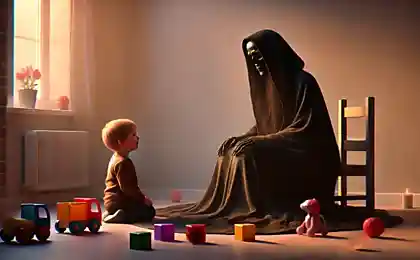1486
Professor of medicine: the death - is not the end
Amazing article by Professor Paul Robert Lanza of Medicine, which scientifically proves that death - is an illusion

Professor of Medicine, Robert Lanza Paul, known for his research
in the field of stem cell research and cloning, it is also
the creator of a new scientific theory - biocentrism.
Life - it's an adventure that surpasses our usual linear thinking.
After the death of his old friend Albert Einstein said:
"Besso left this strange world a little ahead of me. This means nothing. People like us, know that the distinction between past, present and future - only a stubborn obsession illusion ».
New data also suggest that Einstein was right: death - is an illusion.
Our classic way of thinking is based on the belief that the world has an objective existence independent of the observer. But many experiments show that just the opposite. We believe that life is only active carbon and mixtures of molecules: a time we live in, and then rotting in the ground.
We believe in death because we were taught that we die. In addition, of course, because we associate ourselves with our body, and we know that the body die. End of story. But biocentrism, the new theory concerning all, tells us that death can not be a terminal event we think. Amazingly, if you add that life and consciousness into the equation, it is possible to explain some of the biggest mysteries of science. For example, it becomes clear why space and time - and even the properties of matter itself - depend on the observer. It also becomes clear why the laws and constants of the forces of the universe seem perfectly matched for life.
While we are not aware of the universe in our heads, trying to understand the reality remain road to nowhere. Take a look at the weather "outside": you can see the blue sky, but the cells of your brain can be changed so that the sky will look like green or red. In fact, with the use of genetic engineering, we could make it so that all the red will vibrate or make noise, or even cause you desire, as it happens in some birds. Do you think that now the light, but your brain currents can be changed so that you will see the twilight. Do you think that now it is hot and humid, but the weather is tropical frogs seem cold and dry. This logic applies to almost everything. Bottom line: what you see, can not be present without your consciousness.
In truth, you can not see anything through the bone that surrounds your brain. Your eyes - this is not the portals in the world. Everything that you see and experience now, even your body, it's a whirlwind of information that takes place in your mind. According biocentrism, space and time are not the hard, cold objects, we think. Wave your hand in the air, if you take all that's left? It's nothing. The same applies to time. Space and time are merely tools to accommodate all.
Consider the famous two-slit experiment.
When scientists observe the passage of particles through the two slits of the barrier, the particle behaves like a bullet passes through a slit or through another. But if not observed, it acts as a wave and can pass through both slits simultaneously. So, how can a particle change its behavior depending on whether you see it or not? The answer is simple: the reality - a process that involves your mind.
Or, for example, take the famous Heisenberg uncertainty principle. If indeed there is a world outside, where the particles randomly jump, then we should be able to measure all of their properties. But we can not. For example, accurate position and momentum of the particles can not be known at the same time. So why a particle must have a value that you have decided to do the measurements? And a pair of "quantum entangled", ie having a common origin, the particles can instantly communicate with each other from opposite ends of the galaxy as if time and space do not exist? Again, the answer is simple: because they are not just "outside" - space and time are the tools of the mind.
Death does not exist in a timeless, spaceless world. Immortality does not mean infinite existence in time, but it is out of time at all.
Our linear way of thinking about time does not match well with the other series of recent experiments. In 2002, scientists have shown that the particles of light, photons, knew in advance that their distant twins would do in the future. They tested the relationship between pairs of photons. They interrupted the movement of a single photon, and he had to decide whether it will be a wave or a particle. The researchers increased the distance that was required of the other photon to get to your detector. However, they could place a polarizer on its way to prevent its conversion into the particle. Somehow, the first particle learned that the researcher is going to do before it happened, in the distance, instantly, as if there was no space and no time between them. She decided not to become a particle even before her twin met polarizer. It does not matter how we conduct the experiment. Our mind and his knowledge - the only thing that determines the behavior of the particles. Experiments have consistently confirmed the effect, depending on the observer.
Surprisingly? Consider another experiment that was recently published in the prestigious scientific journal «Science». Scientists in France, directing photons into the unit, have demonstrated that their actions could retroactively change what has already happened in the past. When photons reaching ramifications in the office, they had to decide whether to behave as a particle or as a wave when it enters the beam splitter. Later, after the photons were branching, the experimenter could accidentally activate or deactivate the second beam splitter. It turns out that the decision of the observer at this point determines how particles acted, passing before branching. In other words, at this moment the experimenter chose his past.
Of course, we live in the same world. But critics argue that such a phenomenon limited to the microcosm. However, this idea of two worlds (ie one set of physical laws for small objects, the other for the rest of the universe, including us) has no foundation and is being challenged in laboratories around the world. A few years ago, researchers published a paper in the journal «Nature», showing that quantum behavior manifests itself in everyday reality. Couples vibrating ions were aligned coaxial to their "entanglement" and their physical properties were tied when they were separated by great distances ("eerie action at a distance," as Einstein said about it). Other experiments with large molecules, so-called "fullerenes", and show that quantum reality extends beyond the microscopic world. And in 2005 KHC03 crystals showed the effect of "confusion" as half an inch tall - so quantum behavior manifests itself in the world of ordinary human scale.
We reject the idea of multiple universes of Star Trek series as a fiction, but it turns out in this popular genre is something more than just pieces of scientific truth. One well-known aspect of quantum physics is that monitoring can not be completely predicted. Instead, there are a number of possible cases with different probabilities. One of the main explanations of the theory of "many worlds", claims that each of these possible observations corresponds to a different universe ("the multiverse"). There are an infinite number of universes, and all that could theoretically happen to some of the universe takes place. Death does not exist in any real sense in these scenarios. All possible universes exist simultaneously, regardless of whether that occurs in any of them.
Life - it's an adventure that surpasses our usual linear thinking. When we die, we do it not in a matrix of the laws of mechanics billiard ball, but inevitable in the matrix of life. Life has a non-linear dimension; that as long flower that returns to bloom in the multiverse.
"The influence of the senses" - Ralph Waldo Emerson said, - "Most people overcome the mind to such an extent that the walls of space and time began to seem solid, real and insurmountable, and talk about them lightly in the world is a sign of madness».
Robert Lanza M.D.

Professor of Medicine, Robert Lanza Paul, known for his research
in the field of stem cell research and cloning, it is also
the creator of a new scientific theory - biocentrism.
Life - it's an adventure that surpasses our usual linear thinking.
After the death of his old friend Albert Einstein said:
"Besso left this strange world a little ahead of me. This means nothing. People like us, know that the distinction between past, present and future - only a stubborn obsession illusion ».
New data also suggest that Einstein was right: death - is an illusion.
Our classic way of thinking is based on the belief that the world has an objective existence independent of the observer. But many experiments show that just the opposite. We believe that life is only active carbon and mixtures of molecules: a time we live in, and then rotting in the ground.
We believe in death because we were taught that we die. In addition, of course, because we associate ourselves with our body, and we know that the body die. End of story. But biocentrism, the new theory concerning all, tells us that death can not be a terminal event we think. Amazingly, if you add that life and consciousness into the equation, it is possible to explain some of the biggest mysteries of science. For example, it becomes clear why space and time - and even the properties of matter itself - depend on the observer. It also becomes clear why the laws and constants of the forces of the universe seem perfectly matched for life.
While we are not aware of the universe in our heads, trying to understand the reality remain road to nowhere. Take a look at the weather "outside": you can see the blue sky, but the cells of your brain can be changed so that the sky will look like green or red. In fact, with the use of genetic engineering, we could make it so that all the red will vibrate or make noise, or even cause you desire, as it happens in some birds. Do you think that now the light, but your brain currents can be changed so that you will see the twilight. Do you think that now it is hot and humid, but the weather is tropical frogs seem cold and dry. This logic applies to almost everything. Bottom line: what you see, can not be present without your consciousness.
In truth, you can not see anything through the bone that surrounds your brain. Your eyes - this is not the portals in the world. Everything that you see and experience now, even your body, it's a whirlwind of information that takes place in your mind. According biocentrism, space and time are not the hard, cold objects, we think. Wave your hand in the air, if you take all that's left? It's nothing. The same applies to time. Space and time are merely tools to accommodate all.
Consider the famous two-slit experiment.
When scientists observe the passage of particles through the two slits of the barrier, the particle behaves like a bullet passes through a slit or through another. But if not observed, it acts as a wave and can pass through both slits simultaneously. So, how can a particle change its behavior depending on whether you see it or not? The answer is simple: the reality - a process that involves your mind.
Or, for example, take the famous Heisenberg uncertainty principle. If indeed there is a world outside, where the particles randomly jump, then we should be able to measure all of their properties. But we can not. For example, accurate position and momentum of the particles can not be known at the same time. So why a particle must have a value that you have decided to do the measurements? And a pair of "quantum entangled", ie having a common origin, the particles can instantly communicate with each other from opposite ends of the galaxy as if time and space do not exist? Again, the answer is simple: because they are not just "outside" - space and time are the tools of the mind.
Death does not exist in a timeless, spaceless world. Immortality does not mean infinite existence in time, but it is out of time at all.
Our linear way of thinking about time does not match well with the other series of recent experiments. In 2002, scientists have shown that the particles of light, photons, knew in advance that their distant twins would do in the future. They tested the relationship between pairs of photons. They interrupted the movement of a single photon, and he had to decide whether it will be a wave or a particle. The researchers increased the distance that was required of the other photon to get to your detector. However, they could place a polarizer on its way to prevent its conversion into the particle. Somehow, the first particle learned that the researcher is going to do before it happened, in the distance, instantly, as if there was no space and no time between them. She decided not to become a particle even before her twin met polarizer. It does not matter how we conduct the experiment. Our mind and his knowledge - the only thing that determines the behavior of the particles. Experiments have consistently confirmed the effect, depending on the observer.
Surprisingly? Consider another experiment that was recently published in the prestigious scientific journal «Science». Scientists in France, directing photons into the unit, have demonstrated that their actions could retroactively change what has already happened in the past. When photons reaching ramifications in the office, they had to decide whether to behave as a particle or as a wave when it enters the beam splitter. Later, after the photons were branching, the experimenter could accidentally activate or deactivate the second beam splitter. It turns out that the decision of the observer at this point determines how particles acted, passing before branching. In other words, at this moment the experimenter chose his past.
Of course, we live in the same world. But critics argue that such a phenomenon limited to the microcosm. However, this idea of two worlds (ie one set of physical laws for small objects, the other for the rest of the universe, including us) has no foundation and is being challenged in laboratories around the world. A few years ago, researchers published a paper in the journal «Nature», showing that quantum behavior manifests itself in everyday reality. Couples vibrating ions were aligned coaxial to their "entanglement" and their physical properties were tied when they were separated by great distances ("eerie action at a distance," as Einstein said about it). Other experiments with large molecules, so-called "fullerenes", and show that quantum reality extends beyond the microscopic world. And in 2005 KHC03 crystals showed the effect of "confusion" as half an inch tall - so quantum behavior manifests itself in the world of ordinary human scale.
We reject the idea of multiple universes of Star Trek series as a fiction, but it turns out in this popular genre is something more than just pieces of scientific truth. One well-known aspect of quantum physics is that monitoring can not be completely predicted. Instead, there are a number of possible cases with different probabilities. One of the main explanations of the theory of "many worlds", claims that each of these possible observations corresponds to a different universe ("the multiverse"). There are an infinite number of universes, and all that could theoretically happen to some of the universe takes place. Death does not exist in any real sense in these scenarios. All possible universes exist simultaneously, regardless of whether that occurs in any of them.
Life - it's an adventure that surpasses our usual linear thinking. When we die, we do it not in a matrix of the laws of mechanics billiard ball, but inevitable in the matrix of life. Life has a non-linear dimension; that as long flower that returns to bloom in the multiverse.
"The influence of the senses" - Ralph Waldo Emerson said, - "Most people overcome the mind to such an extent that the walls of space and time began to seem solid, real and insurmountable, and talk about them lightly in the world is a sign of madness».
Robert Lanza M.D.
























